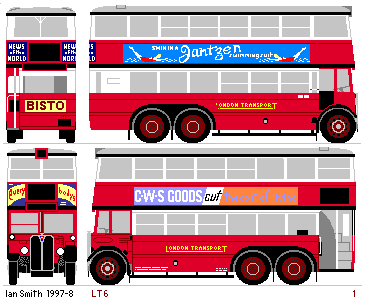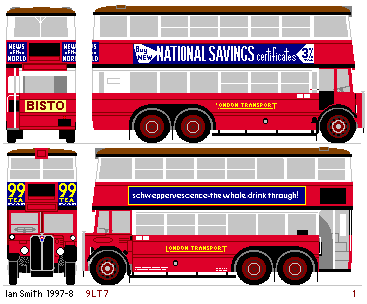
Prepared by Ian Smith
created December 1997, updated 21st October 1999
The Bluebird LTs: LT 741, LT951-999, LT1204-1426 (Total 273) One of the 1931 buses was kept back for a radical experiment: LT741.
The chassis was fitted with a completely new design of body:
the upper saloon was carried forward over the cab for a full bay,
and the lower saloon was enlarged by having a
rear staircase that bent through a right angle.
This enabled longer transverse-facing seats over the rear wheels, five on each side.
The extra bay of seating created upstairs meant that the seating capacity was now 60
(34/26) instead of the previous paltry 54.
To keep within the overall weight limit new light-weight seats were used.
The effect was to create a remarkably good-looking bus.
A drawback was the continuation of the LT1 style of tiny displays on front and back.
One of the 1931 buses was kept back for a radical experiment: LT741.
The chassis was fitted with a completely new design of body:
the upper saloon was carried forward over the cab for a full bay,
and the lower saloon was enlarged by having a
rear staircase that bent through a right angle.
This enabled longer transverse-facing seats over the rear wheels, five on each side.
The extra bay of seating created upstairs meant that the seating capacity was now 60
(34/26) instead of the previous paltry 54.
To keep within the overall weight limit new light-weight seats were used.
The effect was to create a remarkably good-looking bus.
A drawback was the continuation of the LT1 style of tiny displays on front and back.
After displaying LT741 the LGOC experimented further. A long six-cylinder diesel engine was fitted, that required a 5ft 2.5in bonnet. The bus was now too long, so the body was rebuilt in a shortened form to take it. At the same time the body was fitted with new displays, taking the experience with the LT5/1 body and applying it to this new style. Here the 3-piece display did not look a shambles, but had a degree of unity. At the rear the final destination line was supplemented by a large via-points panel placed symmetrically above the platform window (which placed it NOT on the bus centre-line). A further large panel appeared on the side over the platform: someone had realised that the travelling public actually wants to know where the vehicle is going (something the railways haven't realised even yet!). Meantime LGOC had a second prototype body built, using one from the 1931 batch, prior to full-scale production. The new bodies had new blue moquette on the seating, which quickly gave rise to the soubriquet of "Bluebird" for these buses. The main production run of 250 Bluebirds (258 bodies) came on-stream in 1932, with a mix of engines and transmissions again:
London Transport plumped for diesel engines in 1934, and the 5LT5 group (crash gearboxes) were all converted. The Plumstead preselectors (6LT6/1) (by now LT964, 1235-1238 and 1330-1354) retained their petrol engines.
A follow-on group totalling 22 Bluebirds were the last six-wheel motorbuses for London:
12 of them, LT1405-1416, were peculiar in having offside fuel tanks only.
From the number and the timing one can speculate that they were originally intended to
have front doorways (on the nearside of course),
and be low-height versions for the 410 route.
But the Country department bought the 12 Godstone STLs,
and these twelve oddities, coded 10LT8, with full-height Bluebird open-platform bodies,
but with only offside tanks, came to the Central area.
The Bluebirds disappeared in the late forties as the new generation of buses came along.
The preselectors congregated at Plumstead,
where the last petrol survivors were joined in 1949 by some diesel cousins from Hanwell.
The last went from Upton Park (U) with the turn of the decade.
|

 Bluebird histories
Bluebird histories Bus Stop
Bus Stop LT index.
LT index. Part 3: Insiders.
Part 3: Insiders. Bluebirds.
Bluebirds.